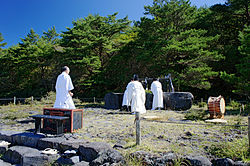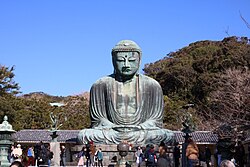
Back الدين في اليابان Arabic Yaponiyada din Azerbaijani জাপানের ধর্মবিশ্বাস Bengali/Bangla Náboženství v Japonsku Czech Religion in Japan German Religio en Japanio Esperanto Religión en Japón Spanish دین در ژاپن Persian Religion au Japon French जापान में धर्म Hindi


Religion in Japan is manifested primarily in Shinto and in Buddhism, the two main faiths, which Japanese people often practice simultaneously. According to estimates, as many as 80% of the populace follow Shinto rituals to some degree, worshiping ancestors and spirits at domestic altars and public shrines. An almost equally high number is reported[6] as Buddhist. Syncretic combinations of both, known generally as shinbutsu-shūgō, are common; they represented Japan's dominant religion before the rise of State Shinto in the 19th century.[7]
The Japanese concept of religion differs significantly from that of Western culture. Spirituality and worship are highly eclectic; rites and practices, often associated with well-being and worldly benefits, are of primary concern, while doctrines and beliefs garner minor attention.[8] Religious affiliation is an alien notion. Although the vast majority of Japanese citizens follow Shinto, only some 3% identify as Shinto in surveys, because the term is understood to imply membership of organized Shinto sects.[9][10] Some identify as "without religion" (無宗教, mushūkyō), yet this does not signify rejection or apathy towards faith. The mushūkyō is a specified identity, which is used mostly to affirm regular, "normal" religiosity while rejecting affiliation with distinct movements perceived as foreign or extreme.[11][12]
- ^ Japan - Country. CIA, Government of the United States.
- ^ a b "Population Estimates Monthly Report - December 1, 2020 (Final estimates)".
- ^ CIA World Factbook:[1]
- Shinto: 70.5%
- Buddhism: 67.2%
- Christianity: 1.5%
- Other: 5.9%
Percentages calculated using the official total population figure of 126,088,000 as of the end of 2020.[2]
- ^ "ISSP" (PDF). NHK. 2018.
- ^ 宗教年鑑 令和3年版 [Religious Yearbook 2021] (PDF) (in Japanese). Agency for Cultural Affairs, Government of Japan. 2021.
- ^ Population figures from the Agency for Cultural Affairs Religious Yearbook 2021, as of the end of 2020, are as follows:[5]
- Shinto: 87,924,087
- Buddhism: 83,971,139
- Christianity: 1,915,294
- Other: 7,335,572
Percentages calculated using the official total population figure of 126,088,000 as of the end of 2020.[2]
- ^ Reischauer, Edwin O.; Jansen, Marius B. (1988). The Japanese today: change and continuity (2nd ed.). Belknap Press of Harvard University Press. p. 215. ISBN 978-0-674-47184-9.
- ^ Kisala, Robert. 2006. Japanese Religions. Pp. 3-13 in Nanzan Guide to Japanese Religions, ed. Paul L. Swanson and Clark Chilson. Honolulu: University of Hawaii Press.
- ^ Engler, Price. 2005. p. 95
- ^ Williams, 2004. pp. 4-5
- ^ Kawano, Satsuki. 2005. Ritual Practice in Modern Japan: Ordering Place, People, and Action. Honolulu: University of Hawaii Press.
- ^ LeFebvre, J. (2015). "Christian wedding ceremonies: 'Nonreligiousness' in contemporary Japan". Japanese Journal of Religious Studies, 42(2), 185-203
© MMXXIII Rich X Search. We shall prevail. All rights reserved. Rich X Search